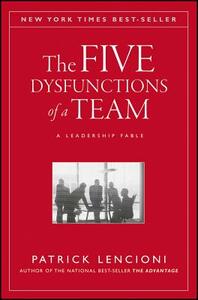Take a photo of a barcode or cover
informative
slow-paced
Finished this in one sitting! I really appreciated and enjoyed how Lencioni framed these principles and concepts into a narrative layout; that way I am able to see reasonable ways that this could be digested and challenged in a staged yet realistic corporate/organizational setting. Then, at the end of the narrative, there was a more “textbook” layout as to the Five Dysfunctions Model and potential suggestions to overcome the dysfunctions based on where you may feel your team is at. Pretty good stuff – I’m saving the final star for my own application to run this model and prove it!
Loved how the first two thirds are written as an interesting novel that makes it easier to absorb the lessons rather than falling back on giving examples of the most successful companies. And that is followed by specific exercises a team can do to reduce their dysfunctions.
WOW! Great read and love the way that it puts us right in the middle of the story. Great stuff, can't wait to improve on the dysfunction!
I enjoy Patrick Lencioni's style of using a story with characters, a plot, conflict, etc, to bring the reader through the points he is trying to make, rather than simply laying them out in a traditionally dry style.
I read this book first of the nine books I have read by this author, and it was a pretty good introduction to his style. He tends to recycle characters and places between his narratives, which is amusing, and also fun for someone like me who grew up in the San Francisco Bay Area, where all of his narratives take place.
The book describes five dysfunctions, and their impact on a leadership team (in this case, the C-level executives of a struggling company) that has just brought on a new CEO to try to turn the company around. The new CEO, Kathryn, introduces the leadership team to the five dysfunctions and guides them through making changes to overcome these issues.
In a nutshell, they boil down to these five items:
1) Lack of trust
2) Lack of healthy conflict
3) Lack of clarity in decision making
4) Lack of accountability
5) Lack of focus on results
The narrative does not go into deep detail about how overcoming these issues is implemented, as the story focuses on the leadership team itself during its offsite meetings, but it is easy for the reader to fill in the gaps and imagine how it happened, and to lend credence to the story's conclusion that the CEO was in fact able to turn the company around by fixing these issues.
I think this book would be a useful and entertaining read for any leader, including those who, like myself, are not C-level executives, but ordinary managers trying to improve their effectiveness as a team leader.
I read this book first of the nine books I have read by this author, and it was a pretty good introduction to his style. He tends to recycle characters and places between his narratives, which is amusing, and also fun for someone like me who grew up in the San Francisco Bay Area, where all of his narratives take place.
The book describes five dysfunctions, and their impact on a leadership team (in this case, the C-level executives of a struggling company) that has just brought on a new CEO to try to turn the company around. The new CEO, Kathryn, introduces the leadership team to the five dysfunctions and guides them through making changes to overcome these issues.
In a nutshell, they boil down to these five items:
1) Lack of trust
2) Lack of healthy conflict
3) Lack of clarity in decision making
4) Lack of accountability
5) Lack of focus on results
The narrative does not go into deep detail about how overcoming these issues is implemented, as the story focuses on the leadership team itself during its offsite meetings, but it is easy for the reader to fill in the gaps and imagine how it happened, and to lend credence to the story's conclusion that the CEO was in fact able to turn the company around by fixing these issues.
I think this book would be a useful and entertaining read for any leader, including those who, like myself, are not C-level executives, but ordinary managers trying to improve their effectiveness as a team leader.
informative
inspiring
fast-paced
informative
medium-paced
The story was quite idealistic.
I was able to relate to a lot of scenarios and appreciated reading how one could handle the situation and improve it.
I was able to relate to a lot of scenarios and appreciated reading how one could handle the situation and improve it.
This book has a lot of good material for thinking about how to build a strong, successful team, but I hated that it was told like a fable. First of all, a fable has animal or mythical characters and is short. Second of all, it reads like a bad novel, while the point of it is to give you strategies for repairing and building your team. It reads like fiction but actually its purpose is non-fiction. I found myself wanting a straightforward walk through of the five dysfunctions instead of the longer "fable."
informative
medium-paced

